

How to Genrefy a Library: A Beginner's Guide to Getting Started. Have you ever felt a little lost or overwhelmed in a library as you try to find a good book?
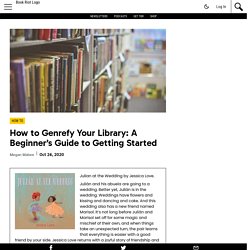
I know I have before. I’ll never forget an experience I had as a 6th grader. Our teacher often brought us to our school’s library, but no matter how frantically I scoured the shelves, I struggled to find a book that appealed to me. When I stumbled upon the book Ella Enchanted (still a favorite of mine), I began checking it out throughout the school year. I loved this book so much, I reread it to avoid facing the formidable task of finding something new. So, What Does Genrefy Mean? In a library, genrefication is the process of assigning genres to books with the intent of helping patrons find books of interest. Check Your Shelf Newsletter. Genrefying the fiction collection. ‘What sort of books do you like reading?’
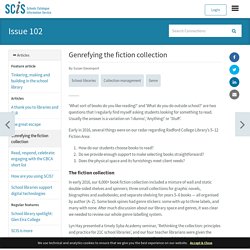
And ‘What do you do outside school?’ Are two questions that I regularly find myself asking students looking for something to read. Usually the answer is a variation on ‘I dunno’, ‘Anything!’ Or ‘Stuff’. When you talk too much for Twitter. Genrefying Your Collection Without Changing Call Numbers. This image perfectly sums up why I am a fan of genrefying library collections and why I have gone through the process in two libraries.

And volume matters. Like a lot. Here's what the research tells us about kids, reading and volume: “Children must have easy – literally fingertip – access to books that provide engaging, successful reading experiences throughout the calendar year if we want them to read in volume.” Ditching Dewey – Mighty Little Librarian. I’ve been planning to hammer out this post for a while, and now that I’ve finished my grad school portfolio defense and have had some time to just chill out this week on Spring Break I’M READY!
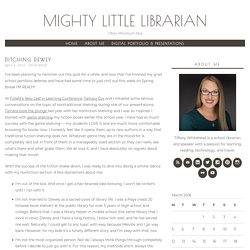
At Follett’s New Leaf in Learning Conference, Tamara Cox and I initiated some serious conversations on the topic of nontraditional shelving during one of our presentations. Tamara took the plunge last year with her nonfiction shelving and I was so inspired. I started with genre shelving my fiction books earlier this school year. I have had so much success with the genre shelving — my students LOVE it and are much more comfortable browsing for books now.
I honestly feel like it opens them up to new authors in a way that traditional fiction shelving does not. With the success of the fiction shake-down, I was ready to dive into doing a similar dance with my nonfiction section. I’m out of the box. I went back and forth with one of my best friends, who is also one of our 6th grade ELA teachers. Un-Deweying a School Library. Project Management: Book Labeling & Re-shelving: Amanda Lanza - ODL Specialist; Justin Hennaut, Valerie Schaffer, Ben Wagner, Jennifer Weaver - ODL Resource TeachersAmanda Amrhine, Library Media Specialist - Chesapeake Terrace Elementary & Kara Sheppard, Library Media Specialist - Bear Creek Elementary Scanning copies and setting Destiny Sublocations: Donna Gruzs & Remi Thunga, ODL Clerks Edgemere Elementary School is a K-5 public school in the Baltimore County Public Schools, the 25th largest school district in the U.S. and 3rd largest in Maryland. 487 students: 47% FARM, 10% Special Education (2014-15) Average class size 22-27 students.
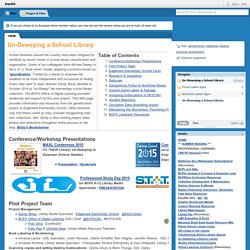
Edgemere ES Library: We did our homework as we planned this project, including consideration of perspectives on both sides of the "Dewey vs. Library Classification 2020. Library Patch: Deweying It My Way. Isn't that the question??

More and more libraries, both school and public, are ditching Dewey and modeling their nonfiction section after popular bookstores. They are grouping their books by major genre topics like animals, war, sports, etc. It has been creating lots of buzz in the library world over the last few years. Here are some bloggers that are talking about this very topic. Are Dewey’s Days Numbered?
By Tali Balas Kaplan, Andrea K.
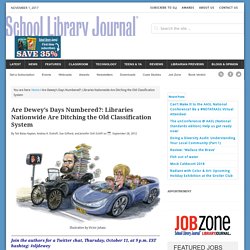
Dolloff, Sue Giffard, and Jennifer Still-Schiff on September 28, 2012 Illustration by Victor Juhasz Join the authors for a Twitter chat, Thursday, October 11, at 9 p.m. EST hashtag: #sljdewey Pushing between snack time and reading group, Zack, a third-grade boy, ducks into our school library while another class is beginning to check out books. With only a moment to spare, the librarian suggests that Zack look above the shelves for the big “Making Stuff” sign, and then search the labels under “P” for paper. Zack’s “Aha!” Time to Ditch Dewey? Time to Ditch Dewey?
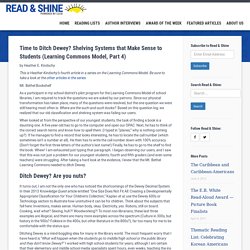
Shelving Systems that Make Sense to Students (Learning Commons Model, Part 4) by Heather E. Kindschy This is Heather Kindschy’s fourth article in a series on the Learning Commons Model. Be sure to take a look at the other articles in the series. As a participant in my school district’s pilot program for the Learning Commons Model of school libraries, I am required to track the questions we are asked by our patrons. When looked at from the perspective of our youngest students, the task of finding a book is a daunting one. On the abandonment of Dewey. Gone are the days of the card catalog.
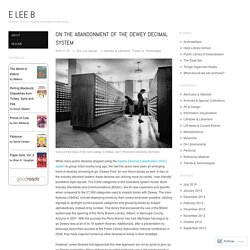
Is Dewey next? [Princeton University Archives] While many public libraries stopped using the Dewey Decimal Classification (DDC) system to group fiction books long ago, the last five years have seen an emerging trend of libraries choosing to go “Dewey Free” for non-fiction books as well. The Dewey Dilemma. By Barbara Fister In the search for better browsability, librarians are putting Dewey in a different class By Barbara Fister — Library Journal, 10/01/2009 Not long ago, a mother blogged about her visit to a newly opened public library in Darien, CT.

Though she appreciated its soaring ceilings, the fireplaces and cozy nooks, the presence of a café, and state-of-the-art technology, what really excited her was the way the books were organized. How user-friendly is your school library. June 28th, 2017By Miriam Tuohy This first post in a series about user-friendly school libraries gets you thinking about how to make it easy for young library users to find what they need. Clearly labelled shelves with room for display encourage students to browse. All rights reserved. "I can't find what I need" “I don’t know where it is.”
If you’ve heard comments like these in your library, you’re right to worry. Deweyless, No Regrets! Librarians Debate the Demise of Dewey. Many may associate school and public libraries with the Dewey Decimal System, but that pervasive underpinning is giving way as librarians seek to foster more user-centered collections. At a virtual Twitter gathering last week, school and public librarians all over the country debated whether Dewey makes finding materials too difficult for young users, and what they are doing about it. The SLJ Twitter chat on Thursday October 11, hosted by Darien Library head of children’s services Kiera Parrott, featured librarians Sue Giffard, Tali Balas Kaplan, Andrea Dolloff, and Jennifer Still-Schiff of the Ethical Culture Fieldston School in New York.
The story of their reorganization of their library to be more intuitive and child-centered, using a system that they call Metis, was SLJ’s October cover story. They and other librarians (using the #sljdewey hashtag) responded to questions about Dewey’s flaws, its relevance in today’s world, and the best ways to encourage library usage among patrons. Organize It However You Like. Mr. Dewey, I Bid you Adieu. In the past I have written posts regarding arrangement of my collection and my constant attempt to make the library as user friendly and accessible as possible.
This is a goal that I believe all librarians can understand. For months I looked into various ways to organize a library's collection. After much consideration I decided to take the plunge and arrange non fiction by subject rather than Dewey. I have read several articles both for and against this arrangement. I have talked to my library friends both locally and members of my PLN in other states.
Here are my main motivations: 1. We Spiced Up the Shelves and Ditched Dewey. Something really big has been happening in the Van Meter School Elementary Library over the last few months. We are always doing things within our library, school, and community to get our young people reading, learning, thinking, collaborating, and creating. One of the ways that we can encourage all of these things within the library is to take a look around and see what changes we can make.
I looked at the way our collection was organized, where and how our students browsed in the library, what books they looked at and checked out, and the books and sections they were not looking at all. Last year when we put all of our Graphic Novels together, this quickly became the most popular place to go in the library.
And it also made me realize how many more Graphic Novels we needed in our collection to support our readers.